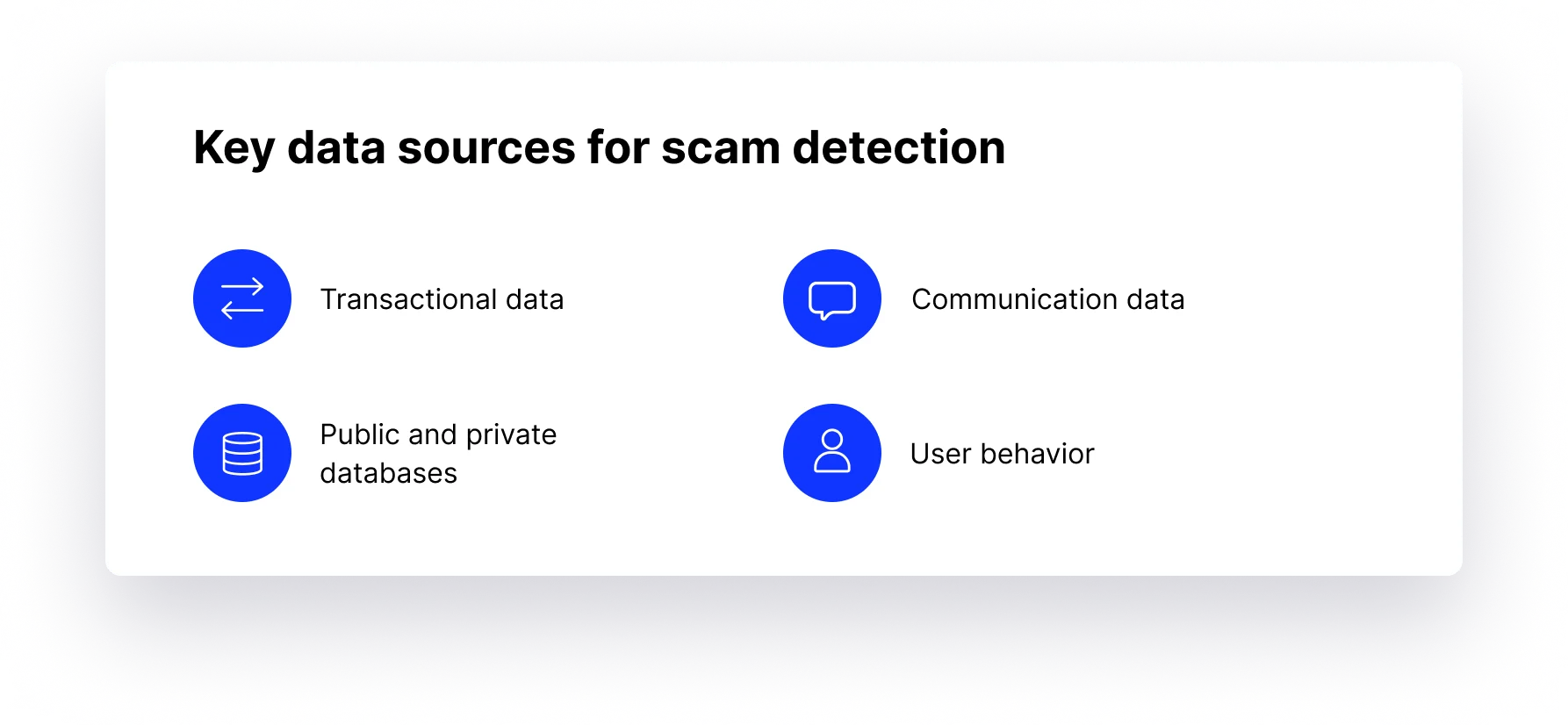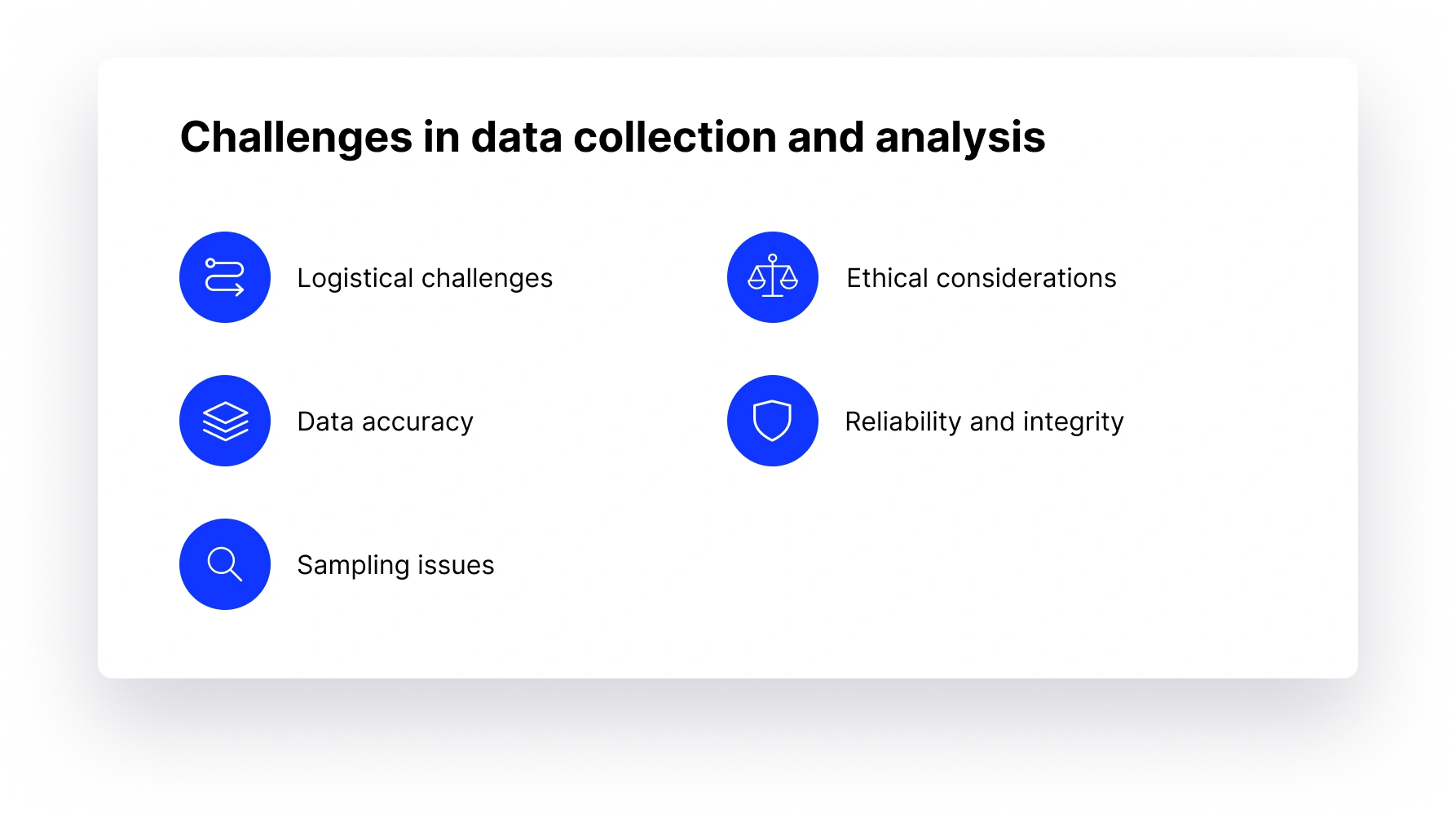Data Sources for Scam Detection and Predictive Analytics

Cybercrime, online fraud, and scams are rising at an alarming rate. The numbers speak for themselves: the rate of global cyber attacks increased by 125% in 2021 as compared to 2020, with industries like finance, insurance, and manufacturing holding the highest share of cyberattacks.
All of this makes scam detection and predictive analysis play a vital role in countering the rising cyber threats, preventing financial loss, elevating user trust, and offering better user experience.
In this article, we will go through all the aspects of scam detection and predictive analysis. So, let us dive into the details.
Understanding Scam Detection and Predictive Analytics
Scam detection refers to the process of identifying suspicious behavior and preventing different attempts to acquire assets, money, or data. Predictive analytics refers to the process of forecasting patterns that result in different future outcomes. It uses a mix of AI, machine learning, data mining, and statistics to reach suitable outcomes.
These analytics play a pivotal role in imparting high-end security in different fields such as e-commerce, finance, and cybersecurity.
They help in examining suspicious transactions, irregular patterns, and unusual trends for investigating fraudulent activity for the prevention of sensitive customer details.
Scam detection faces unique challenges such as phishing, synthetic identity fraud, credential theft, and sophisticated scam schemes that happen immaculately and need immediate handling. So, you can easily overcome these challenges by harnessing the power of a predictive analytics platform.
Key Data Sources for Scam Detection
These sources are integral to identifying and mitigating fraudulent activities, offering a multi-faceted lens through which to examine and understand the diverse tactics employed by scammers.
Transactional Data
Unusual patterns in transactional data should be monitored to understand the occurrence of any fraudulent activity. When a huge sum of money gets transferred to some unrecognized account by exploiting vulnerabilities of digital wallets, transactional data becomes a core of scam detection.
User Behavior
Sometimes, irregular user behavior becomes a red flag for scam detention. When a user performs a completely unrecognized activity, the security system identifies the user patterns to detect different anomalies. In this way, biometrics are used for next-generation scam detection.
Communication Data
With all scammers reaching out via shady messages, calls, and emails, you need to be careful while sharing sensitive information. These phishing scams can turn out to be really tricky in seeking all your passwords and account details in no time. This communication data becomes the source for understanding all scam numbers and emails.
Learn More About AI Credit Scoring Software

Public and Private Databases
Since public databases are less secure, they can easily be accessed by hackers to access background information. Not just this, a few private databases have security vulnerabilities as well which makes it easier for hackers to hack and extract vital details. The database access reports help in the detection of unverified access.

Leveraging Data for Predictive Analytics
Data plays a critical role in predictive analytics as the modeling relies on several types of data to give precision insights and predictions. Let us discuss this in detail.
Historical Data Analysis
The historical data plays the role of a solid foundation for predictive modeling. The data includes past events and records and their outcomes that are important to the problem that you will be predicting. Let us understand this by an example. If you are going to predict customer churn, then the historical data will include past behavior of the customer, purchases, interactions, and at last the outcomes of whether they were churned or not.
Real-Time Data Processing
Real-time data is critical for instant scam detection and prevention as it enables rapid analysis of ongoing activities. By processing current information, algorithms can swiftly identify anomalies, patterns, or deviations that signal potential scams. This immediate response allows for timely intervention, preventing financial losses and protecting users from fraudulent transactions.
Machine Learning and AI
AI and machine learning models utilize diverse data sources to predict and identify scams. The models use transaction data to analyze patterns and anomalies to detect unusual activities, and user behavior data to identify deviations from typical usage patterns that enable it to flag potentially fraudulent activities.
It leverages the geolocation and device attributes to provide context and social media data aids in legitimacy assessment. Both biometric authentication and NLP enhance security. In short, both AI and ML models construct robust profiles by using these vast datasets for proactive scam detection.
Challenges in Data Collection and Analysis
Navigating the intricate landscape of data collection and analysis presents a series of significant and multifaceted challenges. These obstacles not only impact the process of gathering and interpreting data but also influence the accuracy, reliability, and integrity of the insights derived. Understanding these challenges is essential for developing robust methodologies that can withstand scrutiny and yield dependable conclusions.
Sampling Issues
Sampling issues pose challenges in data collection and analysis, potentially leading to biased or inaccurate results. Inadequate sample sizes, non-representative samples, or sampling bias can compromise the validity of findings, hindering the generalizability of conclusions and impacting the reliability of data-driven insights.
Data Accuracy, Reliability, and Integrity
When it comes to data, accuracy, and integrity are critical as without them, the data loses its essence. Incomplete data sets, duplicate entries, and inconsistency in the collection can lead to errors and reduce the quality of insights provided by predictive analysis of the data.
Logistical Challenges
You have to hire highly trained personnel to handle the instruments that you need to store data and invest in robust solutions that can add pressure on your overall budget. Besides this, the whole process of data collection takes a long time. Moreover, there are some geographics and accessibility limitations like remote areas, and conflict zones that act as a barrier in the whole data collection process.
Ethical Considerations
Ethical considerations in data collection and analysis are paramount, posing challenges in preserving individual privacy, preventing discrimination, and ensuring fair practices. Issues like consent, transparency, and the responsible handling of sensitive information are critical. Biases in algorithms can perpetuate discrimination, raising concerns about fairness and justice. Striking a balance between extracting valuable insights and safeguarding ethical principles is crucial.

Best Practices for Effective Data Utilization
Effective data utilization is crucial for deriving meaningful insights and making informed decisions. Here are best practices to enhance the efficiency of data utilization.
- Focus on data accuracy, consistency, and completeness to create a solid foundation for predictive analysis. You can implement proper data validation checks to detect the errors and rectify them as soon as possible.
- Define proper roles and responsibilities for data management and access. Moreover, you have to establish clear data governance policies and procedures to maintain data integrity and security.
- Invest in scalable and flexible infrastructure to handle increasing data volumes. You can leverage the power of the cloud platform for higher elasticity, reliability, accessibility, and cost-effectiveness.
You should always invest in continuous model training and update the set with new data at regular intervals. Here are some of the major benefits of this approach.
- Continuous model training allows algorithms to adapt to the evolving patterns in the ever-changing data landscape.
- The market has a capricious nature and continuous training enables models to respond to shifts in consumer behavior, industry trends, and external factors dynamically.
- Continuous model training supports more informed and timely decision-making, allowing organizations to stay ahead of competitors and market changes.
- Moreover, it enhances accountability by ensuring that models reflect the most recent understanding of the data.
Future of Scam Detection and Predictive Analytics
With the advancement of technology, the future of scam detection and predictive analysis is pretty promising. Here are some trends that will rise in the coming years.
- AI-Driven Automation
Automation will play a vital role and take over the systems that perform routine tasks like ad placement, A/B testing, etc.
- Real-Time Predictions
Predictive analysis will improve by factoring in real-time data and offering better insights to the marketers with updated data. The global e-commerce fraud detection and prevention market is expected to surpass the $100 billion mark by 2027.
- Integration Of AI And Human Expertise
There will be a collaboration between AI systems and human experts to combine the strengths of automated analysis and human intuition for more effective scam detection.
- Data Sources Expansion
There will be the inclusion of a broader range of data sources, including social media, biometric data, and IoT-generated data, for a more comprehensive analysis. The global big data and analytics market was valued at $225.3 billion in 2023 and is expected to rise to $665.7 billion by 2033.
Conclusion
Till now, you’ll be well informed about the importance of having quality data for proper predictive analysis and scam prediction. It acts as a raw material for the algorithms and smart solutions to identify patterns and anomalies to predict potential threats. Quality data empowers models to continuously learn, adapt, and predict emerging scams, ensuring proactive identification and mitigation of risks in the dynamic landscape of digital transactions and interactions.


